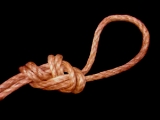
Figure-of-nine loop
Encyclopedia
The figure-of-nine loop is a type of knot
to form a fixed loop in a rope
. Tied in the bight, it is made similarly to a figure-of-eight loop
but with an extra half-turn before finishing the knot.
Also similar to the stevedore loop, the figure-nine loop is generally shown as being based on an intermediate form between the figure-eight knot and the stevedore knot. The Ashley Book of Knots
shows this intermediate knot, in stopper
form, as #521.
While it uses more rope and is bulkier than the figure-of-eight loop, the figure-nine loop is somewhat stronger and less likely to jam. It is sometimes used instead of a figure-of-eight loop to attach a rope to an anchor point or belay.
Knot
A knot is a method of fastening or securing linear material such as rope by tying or interweaving. It may consist of a length of one or several segments of rope, string, webbing, twine, strap, or even chain interwoven such that the line can bind to itself or to some other object—the "load"...
to form a fixed loop in a rope
Rope
A rope is a length of fibres, twisted or braided together to improve strength for pulling and connecting. It has tensile strength but is too flexible to provide compressive strength...
. Tied in the bight, it is made similarly to a figure-of-eight loop
Figure-of-eight loop
A figure-eight loop is a type of knot created by a loop on the bight. It is used in climbing and caving where rope strains are light to moderate and for decorative purposes....
but with an extra half-turn before finishing the knot.
Also similar to the stevedore loop, the figure-nine loop is generally shown as being based on an intermediate form between the figure-eight knot and the stevedore knot. The Ashley Book of Knots
The Ashley Book of Knots
The Ashley Book of Knots is an encyclopedia of knots first published in 1944 by Clifford Warren Ashley. The culmination of over 11 years of work, it contains some 7000 illustrations and more than 3854 entries covering over 2000 different knots. The entries include instructions, uses, and for some...
shows this intermediate knot, in stopper
Stopper (knot)
The term stopper knot has three distinct meanings in the context of knotting and cordage.-At the end of a line:A stopper knot is tied at the end of a rope to prevent the end from unraveling, slipping through another knot, or passing back through a hole, block, or belay/rappel device...
form, as #521.
While it uses more rope and is bulkier than the figure-of-eight loop, the figure-nine loop is somewhat stronger and less likely to jam. It is sometimes used instead of a figure-of-eight loop to attach a rope to an anchor point or belay.

